Money: Introduction
Money is a mode of payment accepted by both sellers and buyers for goods and services. Money is what we give in return when we buy stuff like food, clothes, house, groceries, etc. We give money in return for purchasing anything. This is a simple trade or exchange.
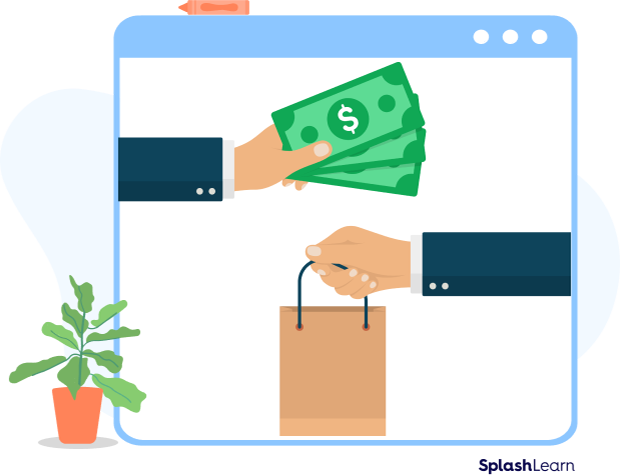
Recommended Games
History of Money
In the old days, when there was no concept of money, people used the barter system. People used to trade goods or services of equal or similar value for other goods, such as tea, food items, labor, weapons, salt, clothing, animals.
Over time, people started using metal coins, gold bars or silver coins. Coins can be considered as an important part of the history of money since it allowed people to count the amount of coins for purchasing different items. That was not the case in the barter system.
Now if we need something, we buy it in exchange for money. There is a fixed price allotted for each and every thing we try to buy. This is known as an advanced form of barter system. In this article, we will learn about money concepts, definition, currency, denomination currency, etc.
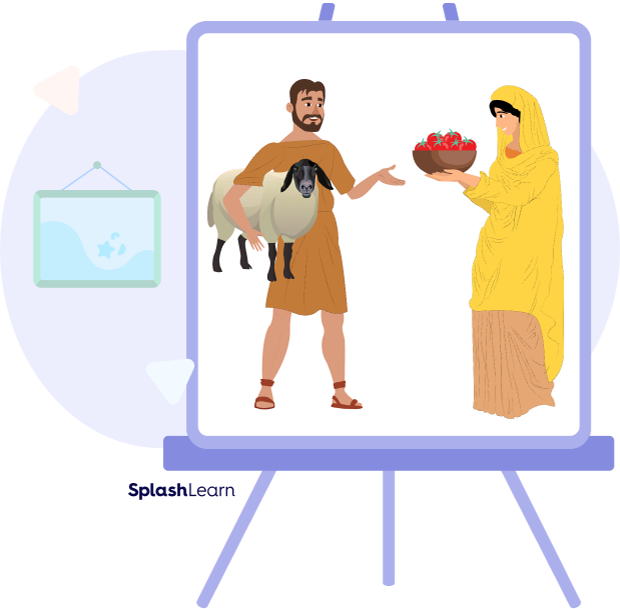
Recommended Worksheets
What Is the Concept of Money in Math?
We deal with money on a daily basis. We need money to buy things and pay for services. Money is a medium of exchange that comes in different forms, like coins or notes that are issued by the government.
Money: Definition
Money can be defined as the medium of exchange, such as notes, coins, and demand deposits, used to pay for commodities and services. The value or price of an item or service is paid for using money. The US dollar is the official currency of the United States of America. A currency is the system of money used in a country. According to economic definition, money is anything that is widely accepted in exchange for goods and services.
Denomination is the stated value or the face value of currency notes or coins. American paper currency comes in seven denominations: $\$1, \$2, \$5, \$10, \$20, \$50$, and $\$100$. Here are the different US dollar bill notes and different cents and coins:
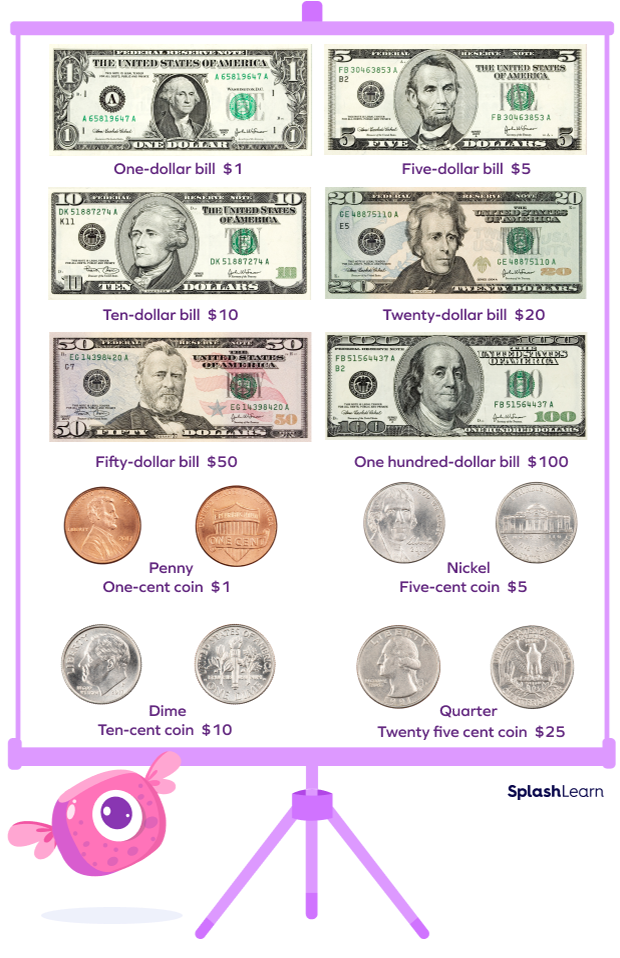
Why Is Money Important?
Money allows us to meet our basic needs such as food, house, healthcare, education, etc., and thereby improve the quality of life. Money is not everything, but it is an essential part of life.
Benefits of Money
Money in this day and age brings us quite close to achieving everything. Let us look at other fundamental aspects of the benefits of having money:
- Money gives us the power to pursue our dreams.
- Money gives us a sense of security.
- Money gives you freedom and independence.
What Are the Functions of Money? Primary and Secondary Functions
Definition of money refers to a common medium of exchange that is issued by the government, which acts as a legal tender for the whole country.
The functions of money can be classified into the following categories:
1. Primary function:
The primary function of money includes valuing money as a medium of exchange and as a measure of value.
- As a medium of exchange—a situation where money is considered to be a mode of exchanging goods.
- As a measure of value—money that helps in determining the worth of goods and services.
2. Secondary function:
The secondary function of money is to store value and serve as a standard of delayed or deferred payment.
What Is Currency?
Currency is the system/mode of money or standardization of money used in a country for general use, especially for people of a particular nation.
Each country has its own value of currency. Different types of money/currencies are used in different countries. Currency is the money in the form of notes or coins issued by the government of a country.
Example: U.S. dollars (US $), Pounds Sterling (£), Euros (€), Japanese Yen (¥), or Indian Rupees (₹ or ₨) etc., are examples of currencies.
Types of Currency
There are many different types of currencies. Some of the new forms do not even have a physical presence yet, but they are popular. We have coins and bills, crypto and many more. Let us have a look at them.
- Coins
Any small metallic, flat, rounded, and authorized by a government is known as a coin. It is used as a prime medium of exchange of money. It may contain some images, numerals, or texts on its surface. It is standardized in weight and is produced in larger quantities. It usually doesn’t hold much value.
In the USA, we have penny, nickel, dime, and quarter, etc.
- Bills
Bills are the form of currency notes issued by the government. They look like paper and are made out of cotton.
In the USA, we have $\$1$ bill, $\$2$ bill, $\$5$ bill, and $\$10$ bill, etc.
- Barter system
It was the ancient system of exchange of goods and services where livestocks were exchanged.
- Crypto currency
Lately, the world is switching to digital forms of currencies. Crypto currency is an emerging name in the field. They do not have any physical appearance but hold values greater than most of the economies.
We have many crypto currencies, such as Bitcoin, Dogecoin, Shiba Inu, etc.
- Plastic cards
Plastic money is what most of us use a lot these days. The credit card, debit card, etc., all are known by the name plastic cards that we use to pay for any goods we purchase.
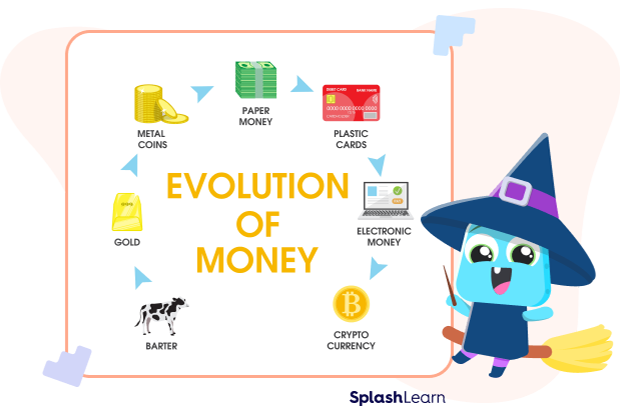
Currency Conversion: Different Currency Names and Value in Dollar (Table)
Let us look at the following chart wherein we compare the different currencies with the USD.
Note: This value is dynamic and keeps changing.
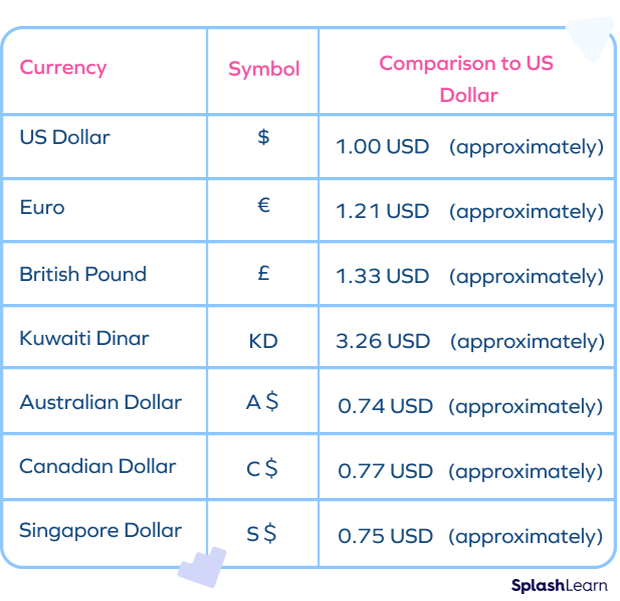
How to Count Money
To count your money, follow the steps below:
- Look at the number printed on each of the dollar bills you have.
- Read all the values on the backs of your coins.
- Sort your bills and coins by value.
- Calculate the value of your coins by multiplying their values to their quantity.
- Add the bill values together.
- Add the total of bills and coins together.
After the end of this process, you will have your value of money that you hold.
Example: Count the given bills.
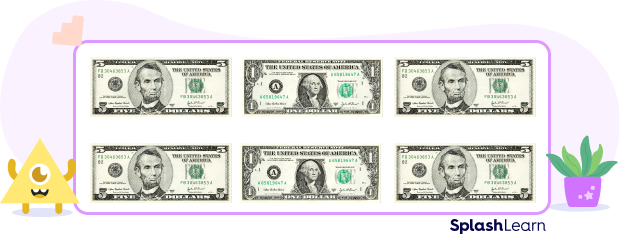
There are four five-dollar bills, and two one-dollar bills.
$\$5 + \$5 + \$5 + \$5 + \$1 + \$1 = \$22$
How Do We Count Money That Is Less Than a Dollar?
It is very important to know how to count money when we are using different coins or notes. The following image shows how different denominations are related.
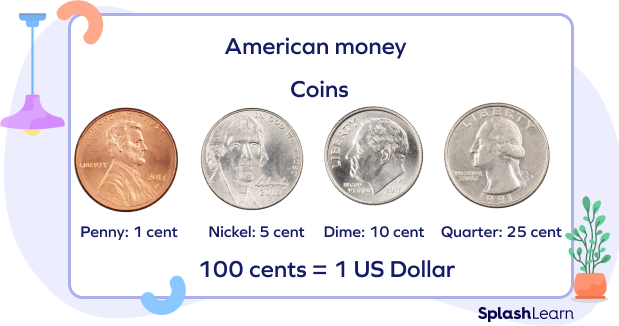
Example: Count the following coins.
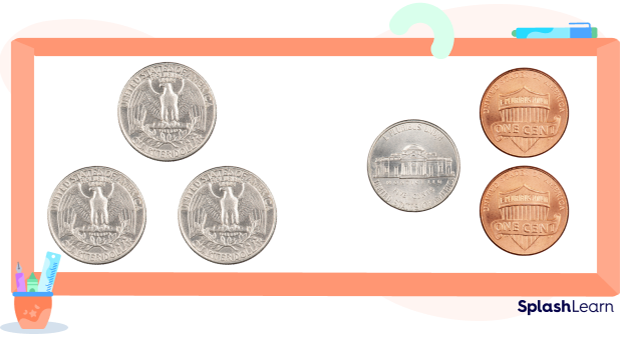
There are 3 quarters, 1 nickel, and 2 pennies.
$25 + 25 + 25 + 5 + 2 = 82$ cents.
How to Manage Money?
We manage money by making good use of it. Now, making good is also known as investing. Let us look at the points below where you can know how to manage your money.
- Creating a budget.
- Saving first and spending later.
- Setting financial goals.
- Starting to invest early.
- Avoid debt.
- Saving.
- Avoiding reckless spending of money.
Use of Money in Math and Real Life
Money is used in real life and math. Math and money are correlated:
- as a medium of exchange,
- for purchasing goods,
- as an offering for service,
- as a sign of wealth,
- in the banking sector,
- in the housing sector,
- in education.
Fun Facts!
- US dollars is the most traded currency around the globe.
- It is believed that livestock and grain were used in the barter system in exchange of goods and services over 10,000 years ago.
Let’s Sing!
Let’s find the total money spent,
Every dollar and every cent!
Know that a penny’s worth one
A nickel’s worth five; and a dime is ten.
A quarter’s twenty-five, so count again!
Let’s Do It!
Instead of handing out money identification worksheets to your child, help them understand how dollar bills can be exchanged for smaller denominations. You can also ask your child to make a piggy bank of his own to save money and maintain a record of how much they add to it, daily or weekly.
Conclusion
In this article, we came to know about money and the different terms coined with it such as currency, different forms of money, etc. We can now look at some examples and solve practice problems to understand money better.
Solved Examples
1. Debbie has 20 dollars in her pocket and she spent 15 dollars buying cupcakes. What amount will be left in her pocket?
Solution:
Debbie has a total amount of 20 dollars and she spent 15 dollars.
The remaining amount in her pocket:
$\$20\;-\;\$15 = \$5$.
Therefore, the amount left in Debbie’s pocket is 5 dollars.
2. If you want to buy a soccer ball from an online Italian site and you are in the USA. The cost of the ball is €100. How much does the ball cost in dollars?
Solution:
The cost of a soccer ball is 100 Euro (€).
1 euro is equal to 1.21 USD. So, the value of 100 Euro (€) is equal to:
$100 \times 1.21$ USD $= 121$ USD.
$\therefore$ The soccer ball cost is 121 USD.
3. When it is needed to pay a shopkeeper 15¢ for an item, it can be paid for with a dime and a nickel. Explain how.
Solution:
$15{¢} = 10{¢} + 5{¢}$
15 cents $= 1$ dime $+ 1$ nickel
4. Express 25 dollars in dimes.
Solution:
We know that 1 dollar $= 10$ dimes.
So, 25 dollars $= 25 \times 10$ dimes $= 250$ dimes.
5. Maya has 15 dollar bills and 40 quarters. How much money does she have?
Solution:
We know that 1 dollar $= 4$ quarters.
1 quarter $= \frac{1}{4}$ dollars $=0.25$ dollars
40 quarters $= \frac{1}{4} \times 40 = 10$ dollars
So, she has 15 dollars $+10$ dollars $= 25$ dollars.
Practice Problems
Concept of Money - Definition With Examples
Lisa has a 100 dollar bill in her purse and she spent 45 dollars buying a dress. What amount will be left in her purse?
Lisa has a total amount of 100 dollars and she spent 45 dollars.
The remaining amount in her pocket-
$\$100\;-\;\$45 = \$55$.
Therefore, the amount left in Lisa’s purse is 55 dollars.
450 rupees $=$ ___ USD (Use 1 rupee $= 0.014$ USD)
1 rupee is equal to 0.014 USD. So, the value of 450 rupees is equal to-
$450 \times 0.014$ USD $= 6.3$ USD.
$\therefore$ The cost of the shirt is 6.3 USD.
10 dimes =
1 dime $= 10$ cents
10 dimes $= 100$ cents $= 1$ dollar
What is the value of 25 dollars in nickels?
We know that 1 dollar $= 20$ nickels.
So, 25 dollars $= 25 \times 20$ nickels $= 500$ nickels.
Maria has 10 dollar bills and 4 quarters. How much money does she have?
We know that 1 dollar $= 4$ quarters.
1 quarter $= \frac{1}{4}$ dollars $= 0.25$ dollars
4 quarters $= \frac{1}{4} \times 4 = 1$ dollar
So, she has 10 dollars $+ 1$ dollar $= 11$ dollars.
Frequently Asked Questions
What is the highest current denomination of USD?
The highest denomination is the $\$100$ bill.
Which denomination is the smallest in dollars?
The smallest denomination of the US is the penny. A penny is $\frac{1}{100}$ of a US dollar.
Which is the oldest currency in the world?
The British pound
How many currencies are there in the world?
There are 180 currencies in the world recognized by the UN.
Who monitors monetary business in the US?
The Federal Reserve plays a role in the US payments system.
































